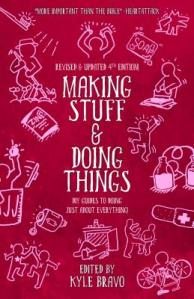Title: Making Stuff and Doing Things: DIY Guides to Just About Everything
Editor: Kyle Bravo
Genre: DIY
Trigger Warnings: Excrement, menstruation
Back Cover:
When you’re young, broke, and in search of a life of adventure, Making Stuff and Doing Things is the most useful book on the planet. It’s an indispensable handbook full of basic life skills for the young punk or activist, or for anyone who’s trying to get by, get stuff done, and live life to the fullest without a lot of money. The book started in the 90s as a series of zines, with dozens of contributors setting down the most important skills they knew in concise, often hand-written pages. If you want to do it yourself or do it together, this book has it all, from making your own toothpaste to making your own art and media, feeding, clothing, cleaning, and entertaining yourself, surviving on little, thriving on less, and staying healthy for all your life’s adventures. You’ll never be bored again.
Review:
This is more of a reference book than a book you’re supposed to read straight through. Personally I think the best way to read it is to skim through it first, then go back and thoroughly read the entries for the projects you’re actually interested in doing.
It’s roughly divided into sections by type of project, but all of the content comes from various punk and anarchist zines in the 90s. A lot of the projects are timeless, but some of them are fairly dated (the one turning an 8-track tape into a hidden storage box comes to mind – I don’t even know where I would find an 8-track tape in 2021). And some of them didn’t seem exactly useful to me, like the one about how to make the socks you wore for a week straight not smell anymore – but that would be more useful to someone in a different situation than me, such as someone who didn’t have access to water to wash their socks or who only had one good pair that they needed to wear repeatedly. There were also several sections that fell into the “modern medicine is bad and you should do homeopathy instead” camp, so be aware of that.
The way to get the most out of this book, I think, is to treat it like a reference book. Read through the sections and projects that interest you. Ignore the rest. Some of them will be useful and some of them won’t apply to your situation or won’t be interesting to you. Take what you need, and ignore the rest.

